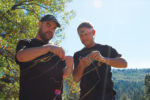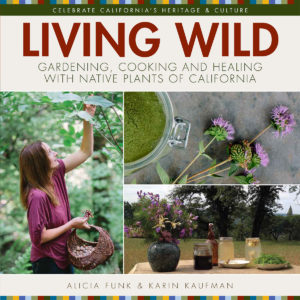Culture
Indigenous California Culture
Our local landscape of plants supported indigenous people for thousands of years. But we have lost the Native Californians’ valuable “user’s manual” that could guide us to the plants we would enjoy eating and the ones we need when we are sick, as well as the
best ways to collect, tend and prepare them. It is my deepest hope to engage with as many indigenous groups as possible in an effort to remember the heritage of sustainable forest management as a way to create healthy food and thriving people.
Indigenous language loss continues to occur at a rapid pace in California and worldwide. Just 200 years ago, at least 80 different languages were spoken in California, making the state the most diverse area of languages of its size. The list below provides plant names in Nisenan (also called Southern Maidu), Konkow (Northwestern Maidu) and Mountain Maidu (Northeastern Maidu). All three languages are part of the Maiduan language family which had about 9,000 speakers before European contact. Today, there are no first-language speakers and only a few first-language descendants working to keep these languages alive.
In the Konkow language, du means bush, ‘ca means tree and sawi means greens and so these terms appear repeatedly in many plant names. Other indigenous names indicate how the plant was used for food, medicine or functional art. Maintaining indigenous languages provides a key to understanding a sustainable and close relationship to the environment we inhabit.
Farrell Cunningham Yatem of the Mountain Maidu, who was active in preserving and teaching Maidu language, served as a primary source for adding and verifying plant names and uses provided in this list. It is only a rough beginning of gathering back together the pieces of information on how to live in this landscape, much of which has been kept private within indigenous communities, or has already been forgotten.
Listen to original Maidu music:
Alder
Alnus rhombifolia
Nisenan su tumync’a; Konkow t’at’am c’a
Alnus incana subspecies tenuifolia
Mountain Maidu c’ic’im c’a
Alumroot Heuchera micrantha
Nisenan omtak
The Nisenan made a tea from the roots for a
strengthening tonic and the Mountain Maidu ate the
leaves as greens.
Aspen, Quaking Populus tremuloides
Konkow wylylym c’a; Mountain Mai du sylylykum c’a
Balsamroot Balsamorhiza sagittata
Mountain Maidu ojwam
The seeds of Balsamorhiza sagittata were enjoyed raw
and pickled.
Bay, California Umbellularia californica
Nisenan sowdasim c’a, Bay nut sojba; Konkow sojba
Bay nuts were cooked in the ashes and enjoyed as a
food and also eaten by women during menstruation.
Leaves were used as an external foot bath and the
Konkow used it as incense to cleanse the bark house and
keep insects away.
Bitter Cherry Prunus emarginata
Mountain Maidu siliwa
The berries were crushed and eaten. The related
Sierra Plum (Prunus subcordata) was also enjoyed and
was called k’as in Nisenan, kasy in Konkow and
maidumkasym and kasym in Mountain Maidu .
Bleeding Heart Dicentra formosa
Nisenan solem
The Nisenan boiled the plant, after leaching it in running
water overnight, and ate it as a spring green. NOTE
Despite a history of internal use by Native Americans, use
externally only, due to potentially poisonous compounds in
the plant.
Blue Flag Iris missouriensis
Iris species
Nisenan de ba
Buckeye, California Aesculus californica
Nisenan polo; Konkow polo; Mountain Maidu
sawom cham, polo
Buckeye seeds were leached overnight in a manner similar
to acorns in a stream or sandy basin. The wood was also
used as fire drills and to stun fish.
Camas Camassia quamash
Mountain Maidu palutem*
Cattail Typha latifolia
Mountain Maidu bokwopum, bakwapa*
Ceanothus Ceanothus species
Mountain Maidu chapatim du
Ceanothus cuneatus Buck Brush
Nisenan padi tym du
The Nisenan used Buck Brush for rough basketry.
Ceanothus integerrimus Deer Brush
Nisenan hi bi; Konkow hi bimtu, hi bi; mountain
maidu hibim dum; chapatim dum
The Nisenan and Konkow used the branches for baskets
and the seeds were ground into flour. The Konkow used
the seeds as a primary seasoning for other foods and
ate the leaves as greens. The roots were boiled to make
a diuretic tea. The Mountain Maidu used the flowers for
soap, shoots for baskets and bark for string.
Ceanothus prostratus Prostrate Ceanothus
Nisenan ‘kompadit; Konkow humc’i; Mountain
Maidu humc’i
Cedar, Incense Calocedrus decurrens
Mountain Maidu manim cha*
Chokecherry Prunus virginiana
Nisenan hanhan; Konkow hanhani;
Mountain Maidu hanhanym, hanani*
The berries were eaten fresh in the fall or dried for future use.
Coffeeberry
Frangula californica
Nisenan la’a’; Konkow sumpiti, sympiti
Coffeeberry tea was made from the roots and used both
externally as a wash and taken internally for poison oak by the Nisenan. The berries were made into beads for
jewelry. The Konkow used small amounts of the berries as
a laxative.
Frangula purshiana
Mountain Maidu sumpitim dum
The Mountain Maidu made a laxative with the bark
and leaves.
Cottonwood Populus trichocarpa
Konkow wylyly; Mountain Maidu lylym, wylylym c’a
Currant
Ribes cereum
Mountain Maidu nunholwam
Ribes nevadense
Mountain Maidu ju’pupym
The berries were eaten fresh or dried.
Dogwood Cornus nutallii
Mountain Maidu tatam cha*; Nisenan so ko jmom
In spring, the blossoms were considered by the Nisenan
as a sign of the time to collect mushrooms.
Douglas-fir Pseudotsuga menziesii
Mountain Maidu liham cha*
The Mountain Maidu used the fronds for baskets,
necklaces, and skirts. The tips were eaten fresh or dried.
Elderberry Sambucus species
Mountain Mai du lokum hini*, nokomhyni; Nisenan nok
Elderberries were mixed with Manzanita berries to make
a general strengthening tonic. The canes were hollowed
to make musical instruments called clappers.
Fern
Note Species not distinguished.
Mountain Maidu, Konkow sulala; Nisenan tatat
The Mountain Maidu smashed the fresh berries and
covered with water to make a beverage.
Gooseberry Ribes menziesii
Nisenan yuhemi; Konkow ‘totokumhene;
Mountain Maidu yuhemi
All of the tribes enjoyed the berries. The Nisenan
sweetened them with powdered Manzanita berries.
The Konkow removed the spines by rubbing the berries
between the hands or between pieces of wood. The roots
were used as a black color in baskets and the young
greens were eaten.
Grape, Wild Vitis californica
Nisenan pi mhyn; Konkow pimily; Mountain Maidu
pimeli*
All tribes ate the fruit. The leaves were used by the
Nisenan to wrap acorn bread before cooking. The
Konkow and Mountain Maidu used the vines to tie house poles together.
Kitkitdizze Chamaebatia foliolosa
Nisenan bu,tis
Lupine Lupinus species
Nisenan pupumpuk; Mountain Maidu puk (“greens”)
The young greens were leached overnight in a stream
and then cooked. CAUTION Do not consume Lupine
internally due to the toxic alkaloids contained in the plant.
Madrone Arbutus menziesii
Nisenan da dakas; Konkow k’awakumc’a, k’owac’i;
Mountain Maidu lil lil cha*
The Nisenan used the berries as food.
Manzanita Arctostaphylos species
Nisenan dokdok; Mountain Maidu e,pum;
Konkow dokdoko
The Nisenan and the Mountain Maidu used the berry
powder as a sweetener. Manzanita cider (jotik in
Nisenan) from the whole berries of all the local species
of Manzanita was made by the Nisenan, the Mountain
Maidu and the Konkow.
Arctostaphylos nevadensis Pine Mat
Mountain Maidu kawydano, kawedanom, kawbano
The Mountain Maidu ate the berries.
Arctostaphylos patula Greenleaf Manzanita
Mountain Maidu dadakasym
The leaves were used as a healing salve or wash sores.
Arctostaphylos viscida Whiteleaf Manzanita
Nisenan kotok
The Mountain Maidu used the berries for cider and as a
sweetener and celebrated Manzanita day, called
kotok buj, to increase the yield of berries.
Maple, Big-leaf Acer macrophyllum
MOUNTAIN MAIDU dapim cham*
The leaves were used to wrap earth-baked foods,
especially acorn bread. The new shoots were heated and
split for basketry and the bark was used for making skirts.
Milkweed
Asclepias fasicularis Showy Milkweed
MOUNTAIN MAIDU pum*
Asclepias cordifolia Purple Milkweed
MOUNTAIN MAIDU pumim*; NISENAN ompu
The inner bark was cleaned, twisted and used as string.
Use as cold remedy according to Nisenan tradition and
as a method of making string by cleaning and twisting
the inner stem bark according to the Koncow and
Mountain Maidu traditions. The ‘milk’ from the stem was
applied to skin ailments by the Koncow.
Mock Orange, Western Philadelphus lewisii
Nisenan jokolo
Mock Orange stems were used for arrow shafts.
Monkeyflower Mimulus species
Nisenan pu sam
The leaves were eaten raw before the plant flowered.
Mugwort Artemisia douglasiana
Mountain Maidu munmuni
Mugwort was used as a tea for colds and other
conditions and burned to cleanse the air.
Nutmeg, California Torreya californica
Nisenan tom
The nut was eaten roasted.
Oak
Quercus douglasii Blue Oak
Nisenan c’akom c’a
The acorns were difficult to crush and so they were not
favored by the women. However, they were occasionally
soaked to soften then leached and mixed with Black Oak
nuts to add flavor.
Quercus kelloggii Black Oak
Nisenan hamsum c’a; Mountain Maidu hamsim cham
Nuts from the Black Oak were the primary, preferred
staple that sustained the Maidu. Even as late as 1905,
when they were no longer a primary food source, a
family of 10 people would typically store at least 40
large flour sacks of shelled acorns. Acorns were typically
shelled and dried in a granary or utim sikun until spring.
Acorns were pounded into a fine flour and placed into
a shallow, sandy hole lined with pine needles. Water
was poured over it until the bitterness was removed and
then the flour was boiled in a basket with hot rocks or
wrapped in leaves and baked in an earth oven. The flour
was later made into a soup or bread.
Quercus lobata Valley Oak
Nisenan lom c’a; Konkow lo wy
The nuts of the Valley Oak were enjoyed by the Nisenan
but their bitter flavor was not liked by the Konkow. The
Konkow occasionally mixed Valley Oak nuts with the nuts
of other Oaks.
Quercus wislizenii
Nisenan babakumc’a; Konkow waja;
Mountain Maidu omhamsymc’a
The Nisenan liked Quercus wislizenii nuts because of
their high oil content and ease of pounding.
Oregon Grape Berberis species; species not
distinguished
Nisenan polpol; Mountain Maidu pompomy
Both tribes drank a tea from the root as a tonic,
which typically means as an overall strengthener for the
immune system.
Pennyroyal
Mountain Pennyroyal (Monardella odoratissima);
Coyote Mint (Monardella villosa)
Mountain Maidu bykuiky*
The Mountain Maidu used the flowers for tea when sick,
but not for pregnant women.
Pine
Pinus ponderosa Ponderosa Pine
MOUNTAIN MAIDU bubum cham*
Pinus contorta subspecies murrayana Lodgepole Pine
MOUNTAIN MAIDU lulum cham*
Pinus lambertiana Sugar Pine
MOUNTAIN MAIDU sumum cham*
Pinus sabiniana Gray Pine
MOUNTAIN MAIDU towanim cham*
The roots of all species of pine were used for baskets. The
bark was used for houses and trays and the needles for
brushes. The pitch was used for glue. The sap of Sugar
Pine was preferred for gum in addition to the nuts as a
food. The seeds of Gray Pine were sought after to eat
and for making jewelry.
Plum, Sierra Prunus subcordata
MOUNTAIN MAIDU kasim cham*
The seeds were used for making beads and the shoots
were used for making baskets.
Poppy, California Eschscholzia californica
Nisenan ta puk
The greens were steamed and eaten.
Redbud Cercis occidentalis
Nisenan ‘pa,; Konkow li l; Konkow luly;
Mountain Maidu lyli
Redbud was preferred for basketry and used extensively.
The flowers were eaten, the bark was used for twining
grass baskets, and the shoots were prepared for wicker
or coiled baskets.
Rose Rosa californica
Nisenan jomoskulkul; Mountain Maidu lilchiche*
Both tribes ate the Rose hips. The Nisenan used the roots
to make a strengthening tea. The wood was used for
baskets and arrows.
Serviceberry Amelanchier utahensis, Amelanchier alnifolia
MOUNTAIN MAIDU sobam dum*
The berries were enjoyed as a food and the straight
shoots were used for basketry.
Soap Plant Chlorogalum pomeridianum
MOUNTAIN MAIDU, Nisenan ho’
The roots were used to make brushes.
Spiraea Spiraea douglasii
MOUNTAIN MAIDU lelem dum*
Strawberry, Wood Fragaria vesca
Nisenan k’awinwase; Konkow hulupiti, hulupitem;
mountain maidu hulupitim
Both tribes enjoyed the raw fruit.
Thimbleberry Rubus parviflorus
Nisenan tumbok
The Mountain Maidu and Nisenan ate the berries and
used the leaves to make diapers.
Toyon Heteromeles arbutifolia
Nisenan jolos; Konkow lo’lo’si
The berries were eaten in the fall and winter after cooking
and crushing. Certain berries, depending on the location
of the bush, tasted better.
Willow Salix species
Nisenan lu humc’up; c’ipa; Konkow c’upy;
Mountain Maidu com, pa*, c’upim
The Konkow and Mountain Maidu used Willow for fishing
traps, nets and stringers. The Nisenan preferred Gray
Willow, lu hum c’upi, for baskets and used another type
of Willow, c’ipa, for work baskets. In Mountain Maidu,
Gray Willow was called hisdom c’upim, meaning
weaving willow.
Yarrow Achillea millefolium
Mountain Maidu wislam buku*, wislamjo; Nisenan
batiwene
The Nisenan and Northeastern Maidu drank a tea made
from the leaves for fever. The Northeastern Maidu also
mashed the leaves and applied to wounds to prevent
infection. The Mountain Maidu ate fresh leaves for sore
throats or drank as a tea.
Yerba Santa Eriodictyon californicum
Mountain Maidu sawi*, jompom saywy; Konkow
jompom saywy; Nisenan wadas
All three groups used Yerba Santa for colds and bad
coughs. The Konkow boiled the leaves and drank the tea.
The Nisenan heated Yerba Santa and then inhaled the
steam for colds and dizziness.





